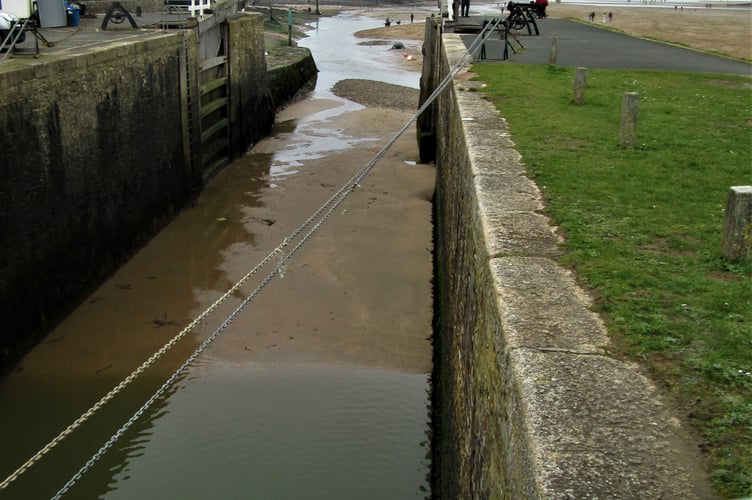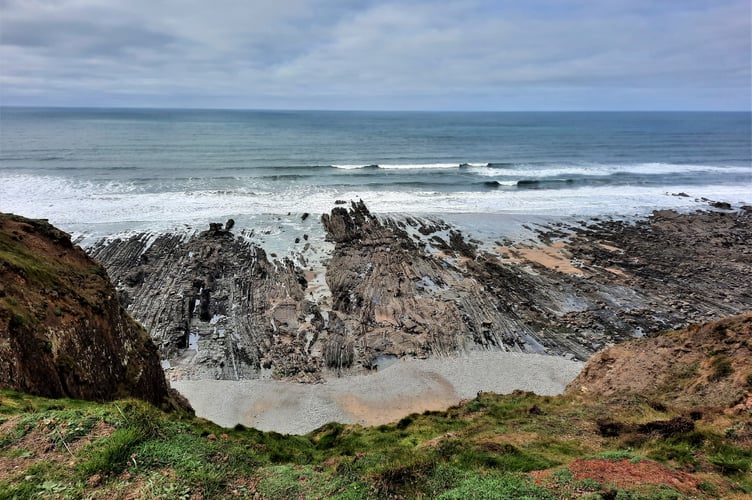About 15 Club members shared cars and parked near Marhamchurch, walking northwards along the towpath of the Bude Canal, which was built about 1823, for 20ft tub boats to bring lime-bearing sand inland for agricultural fertiliser. The boats also carried grain, and coal from South Wales. The arrival of the railway and the manufacture of cheap fertiliser undermined the canal’s commercial purpose so it was closed and sold to the local water company. The canal was regenerated in 2009, brought back into a good state of repair and is now used for leisure activities. There are still 2 locks on the remaining length, but there were 6 inclined planes on the now derelict length further inland.
After Rodd’s Bridge, over the River Neet, is a listed milepost – 1 mile to/from Bude. The River Neet meets the River Strat (hence Stratton) near Marhamchurch and flows out to sea at Summerleaze Beach. There were the usual mallards and moorhens on the canal, but also a less common, and more colourful, mandarin duck.

The group passed a loading wharf on the Bude Canal about half a mile from the sea lock that links the canal to the tidal haven. Bude Harbour has a seaward area, known as Budehaven, and an Inner Harbour with a sea lock connecting them, which gives access to the Bude Canal. This is the only hand operated sea lock in the country. In the 18th century Bude only had a small, unprotected tidal harbour, until the Bude Canal Company built the canal and improved the harbour.
From sea level, the walkers climbed up to the clifftop at Compass Point, to the landmark of Storm Tower, known locally as the Pepperpot, This octagonal tower had points of the compass engraved into the appropriate faces. It was built in the 1830s but, after being battered by the elements, was rebuilt a little inland fifty years later. The constant erosion of the cliffs means that the Storm Tower is again under threat and must once more be dismantled and moved to safety. The Storm Tower, was intended to fulfil three purposes. The principal of these was shipping safety, as vessels were all too frequently wrecked or endangered close to Bude. The tower provided a base for the coastguard, with one window directly aligned on the nearby Coastguard Station, and also as a landmark for ships: when vessels were in danger, a flag was hoisted and tar barrels were set alight as a warning signal. The tower also offered a haven to anyone caught in bad weather on the clifftop. Luckily the ramblers enjoyed a fine, dry day and didn’t need to take shelter.
Following the South West Coast Path, the walkers passed Efford Beacon and the trig point at Efford Down, noticing the ribbed wave-cut platforms that can be seen below the cliffs running out to the sea. There is much evidence of cliff erosion along this coast. The weather remained mild, with a gentle breeze and some sunny intervals.

At Phillips Point, Cornwall Wildlife Trust manage a small nature reserve, where various sea birds can be seen. The group saw 3 choughs and a kestrel in this area. Despite hazy visibility, they enjoyed stunning views from the cliffs, to Hartland Point and Widemouth Bay. It was also possible to see Lundy. A little further along the coast path is Abe’s Rock – but who were Phillip and Abe?
There is a tumulus at Higher Longbeak, a neolithic/bronze age round barrow or burial mound, one of several along this coast. Soon the group turned inland across farmland through Whalesborough to Weir cafe in time for welcome refreshments, after an enjoyable 6 mile walk.
New walkers are always welcome at Okehampton Rambling Club. Please be suitably attired for all weather conditions, including sturdy footwear, and bring drinks and a packed lunch. We meet at the post office in George Street, Okehampton on Sundays, ready to leave at 09.30am. We share cars so please be there in plenty of time so the group can leave promptly. Car drivers with spare seats are encouraged to meet at the post office to offer lifts to non-drivers. If you would like to bring your dog, please contact the leader of the walk to check that the route is suitable.
Next week’s walk will start near The Dartmoor Inn.




